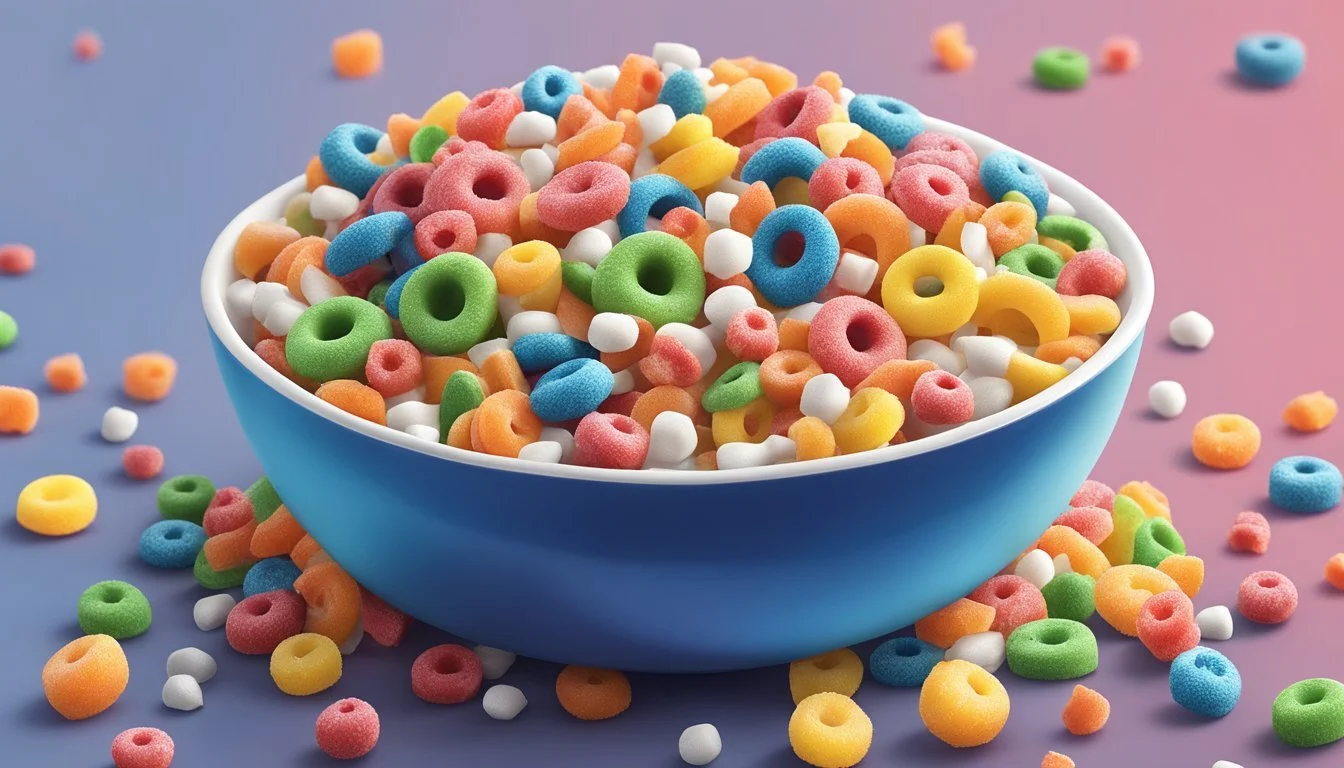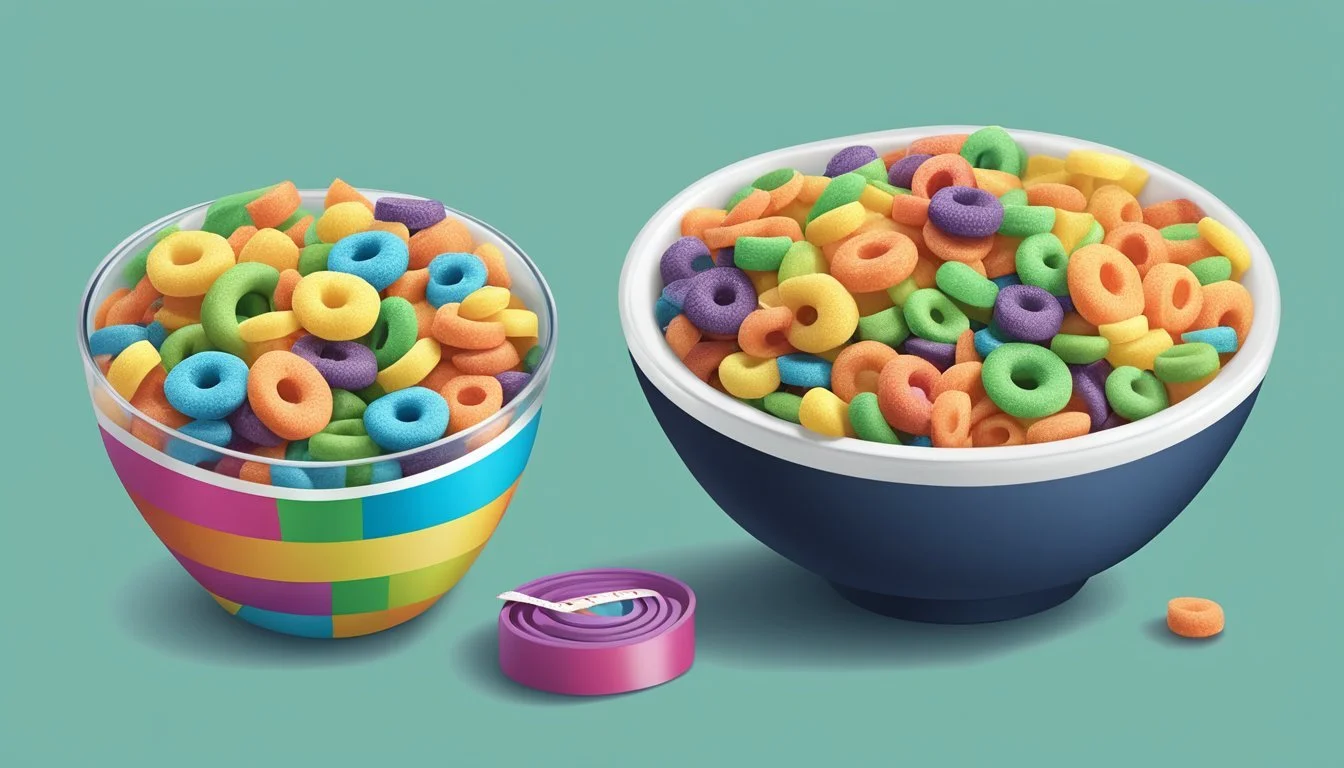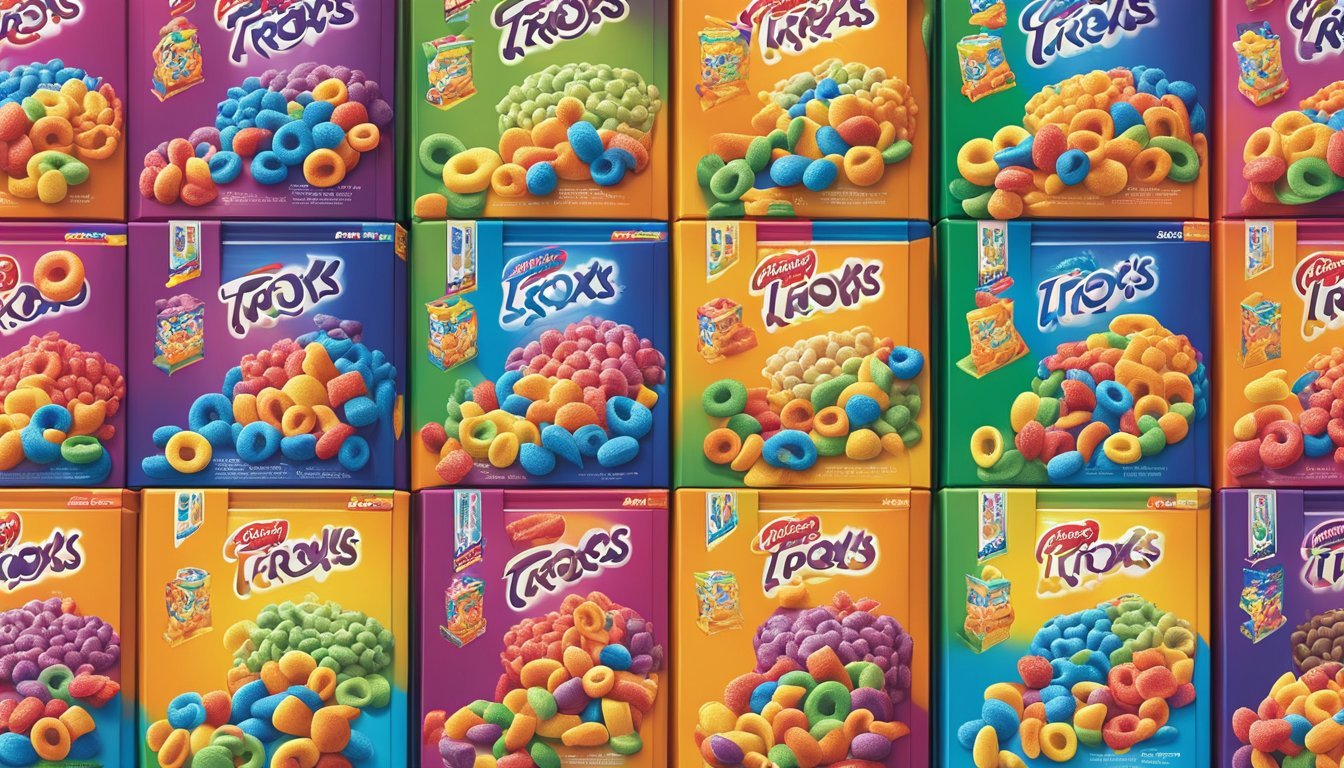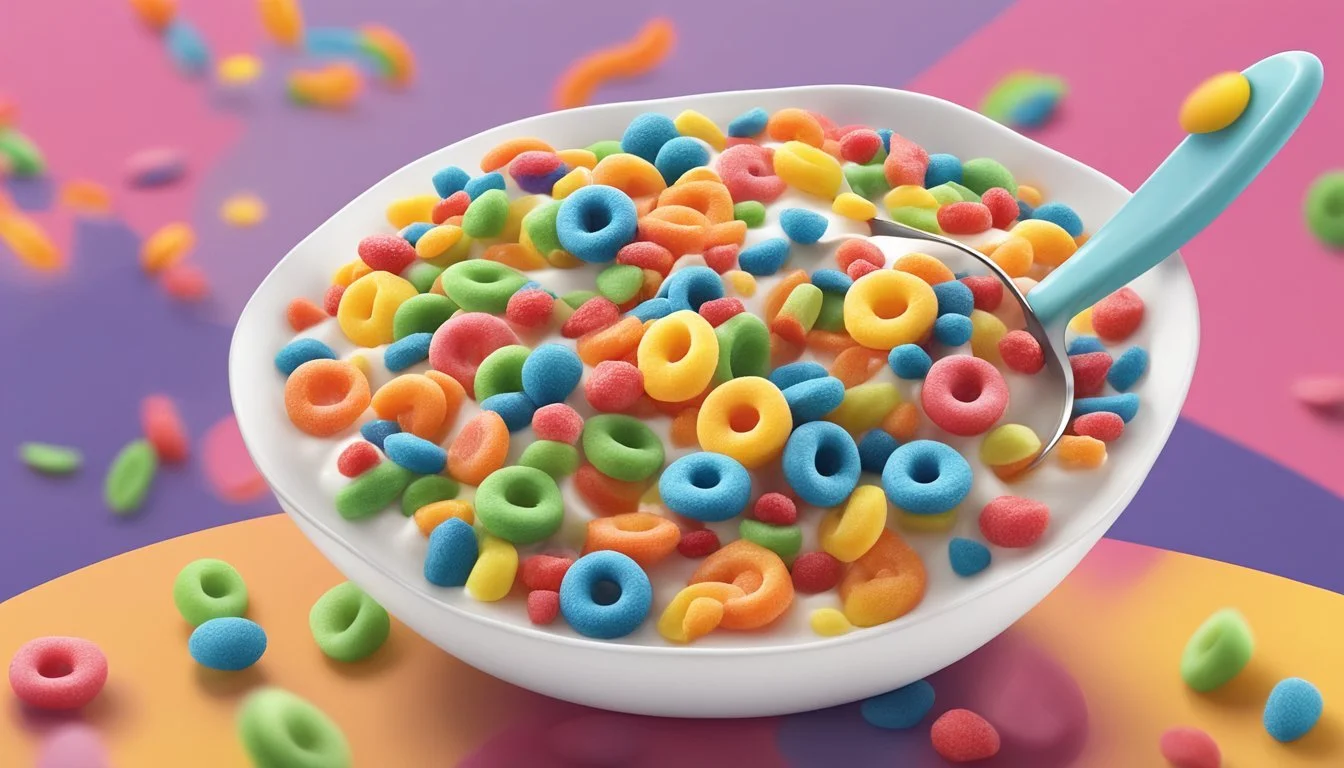Kellogg's Froot Loops vs Trix
A Comprehensive Comparison of Popular Cereals
This Article is Part of Our Breakfast Cereal Guide with Details on Kellogg's Froot Loops Nutrition and Trix Nutrition
When it comes to choosing a colorful and fun breakfast cereal, Kellogg's Froot Loops and General Mills Trix are two of the most popular options. Both cereals are known for their vibrant colors and fruity flavors, but how do they stack up nutritionally? General Mills Trix Cereal contains 31 times more Calcium than Kellogg's Froot Loops, offering a significant nutritional advantage for those looking to increase their calcium intake.
Froot Loops contains 11.0 grams of complex carbohydrates per serving, whereas Trix has 13.0 grams, making a slight difference for those considering their carbohydrate intake. Additionally, while Trix covers your daily need for Zinc 81% more than Froot Loops, both cereals are relatively high in sugar content and should be consumed in moderation.
Choosing between Froot Loops and Trix often comes down to personal preference and dietary needs. For a breakfast that provides a better source of Calcium and Zinc, Trix might be the preferable choice. Parents and breakfast enthusiasts alike might find these facts helpful when deciding which cereal to start their day with.
Brand Histories
Kellogg's Froot Loops and General Mills' Trix are iconic cereals with rich histories that have contributed to their lasting popularity.
Origin of Kellogg's Froot Loops
Kellogg's Froot Loops debuted in 1963. The cereal was introduced as a colorful, fruity option aimed at children. Each loop was designed to be vibrant and enticing.
Kellogg's initially used a highlander as the mascot, but this was short-lived. By the late 1960s, Toucan Sam, an instantly recognizable character, became the face of the brand. His catchphrase, "Follow your nose! It always knows!" became famous.
The cereal's unique flavor profile is often attributed to a blend of citrus and berry notes, setting it apart from other cereals.
General Mills and the Creation of Trix
General Mills launched Trix in 1954. It quickly garnered attention as a sugary, fruit-flavored cereal designed to appeal to both children and their parents.
The cereal was represented by the Trix Rabbit, a mascot who has been featured in marketing campaigns with the tagline, "Silly rabbit, Trix are for kids!" This marketing strategy proved effective and helped solidify Trix as a household name.
Trix was notable for its colorful, puffed corn pieces, which were later transformed into fruit shapes in 1991. While Trix was briefly brought back to its original shape, consumer preference brought back the fruit shapes permanently. General Mills' commitment to maintaining its nostalgic elements has helped keep Trix popular through the decades.
Nutritional Comparison
When examining Kellogg's Froot Loops and General Mills Trix for their nutritional value, it's essential to focus on key components like calories, sugar, protein, fiber, vitamins, and fats. This detailed breakdown will analyze each element based on available data.
Caloric Content and Serving Sizes
Kellogg's Froot Loops and General Mills Trix provide a similar caloric content per serving. Froot Loops typically contain about 110 calories per 1 cup serving. Similarly, Trix offers 120 calories per 1 cup serving.
Serving sizes are essential for comparison; both cereals generally use a 1 cup measure for nutritional information. Evaluating calories in the context of a balanced diet helps consumers make informed breakfast choices.
Sugar Levels
One of the notable aspects of both cereals is their sugar content. Froot Loops contain 12 grams of sugar per serving, while Trix has slightly higher levels, around 13 grams per serving. This factor is crucial for those monitoring sugar intake, especially children who are the primary consumers of these cereals.
Protein and Fiber Content
Protein and fiber are vital for satiety and digestive health. Froot Loops offer 1 gram of protein and 3 grams of fiber per serving, making them a moderate option. Trix provides 1 gram of protein but only 1 gram of fiber, making Froot Loops the slightly better choice for fiber content.
Vitamins and Minerals Profile
Both cereals are fortified with a range of vitamins and minerals. Froot Loops have higher levels of Vitamin C, supplying about 10% of the daily value. They also contain Vitamin B1, B2, B6, B12, and Vitamin D.
Trix, however, excels in calcium content, offering 313mg per serving compared to only 10mg in Froot Loops. Both are good sources of iron, but Trix falls short in other minerals like zinc and magnesium.
Fat Content: Saturated and Unsaturated Fats
Examining the fat content, both cereals are relatively low in fats. Froot Loops contain 1 gram of total fat with 0 grams of saturated fat, 0 grams of monounsaturated fat, and 0 grams of polyunsaturated fat. Trix, similarly, is low in fat, with 1 gram of total fat and almost negligible saturated and unsaturated fats.
This profile makes both cereals low-fat choices, with minimal differences between them regarding fat content.
Ingredient Analysis
Kellogg's Froot Loops and Trix both incorporate distinctive ingredients that contribute to their unique flavors and textures. This section examines their primary ingredients, additives and preservatives, colors and artificial flavors, and whole grains and fiber sources.
Primary Ingredients and Flavors
Kellogg's Froot Loops lists corn flour blend, sugar, and vegetable oil among its top ingredients. It also includes natural fruit flavors, providing a fruity taste that differentiates it from other cereals. Additionally, oat fiber adds to its texture.
Trix by General Mills primarily uses whole grain corn, sugar, and wheat flour. The inclusion of natural flavors enhances its distinct fruity profile, which stands out for being vibrant and appealing to children.
Additives and Preservatives
Froot Loops and Trix contain additives to ensure shelf-life and maintain quality.
Froot Loops incorporates BHT (Butylated Hydroxytoluene) for freshness, sodium as a preservative, and various emulsifiers.
Trix, on the other hand, uses similar preservatives but emphasizes fewer synthetic additives, aligning more with consumer preferences towards less processed ingredients. This includes the use of salt and other common preservatives.
Colors and Artificial Flavors
Both cereals use artificial colors prominently.
Froot Loops contains artificial colors like Red 40, Blue 1, and Yellow 5 & 6, contributing to its vibrant, multi-colored rings.
Trix also utilizes a range of artificial colors, such as Blue 1, Yellow 6, and Red 40. These artificial additions help make the cereal visually appealing. Despite criticism from health advocates, these colors play a crucial role in making the cereals attractive, particularly to younger consumers.
Whole Grains and Fiber Sources
Whole grains and fiber content indicate nutritional benefits.
Froot Loops features a corn flour blend and soluble corn fiber, contributing to its fiber content but not significantly high in whole grains.
Trix highlights its use of whole grain corn and includes wheat flour. These ingredients offer more fiber relative to Froot Loops, making it slightly better for digestive health. The presence of whole grain corn indicates a focus on providing a somewhat healthier choice compared to other sugary cereals.
Health Considerations
Both Kellogg's Froot Loops and General Mills Trix have specific health considerations, including their impact on diet and potential allergens and dietary restrictions.
Dietary Impact
Froot Loops and Trix are comparable in their nutritional profiles, with both containing significant amounts of sugar and carbohydrates. Per serving:
Froot Loops: 35g carbs, including 16g sugar, and 2g protein
Trix: Similar sugar content, contributing to a high glycemic index.
Neither cereal offers substantial protein or fat, making them less ideal for those seeking a balanced breakfast. Froot Loops contains approximately 150 calories per serving, highlighting its role in a low calories diet. The presence of vitamins and minerals in both products is minimal, with limited daily need coverage for essential nutrients. These cereals generally lack whole grains and primarily contain refined grains.
Allergens and Dietary Restrictions
Both Froot Loops and Trix can pose issues for individuals with certain allergens and dietary restrictions. Common allergens present in both cereals include:
Gluten: Neither is gluten-free, posing a risk for those with celiac disease or gluten sensitivity.
Artificial Colors and Flavors: Both cereals employ artificial additives, which may trigger allergies or intolerances in sensitive individuals.
For those on a low sodium diet, both cereals have a moderate sodium content, requiring careful consideration. Due to their high carbohydrate content, they are not suitable for low-carb or low glycemic index diets.
It's important for consumers to check ingredient labels for specific allergens and consider their overall dietary needs when choosing between these cereals.
Product Varieties and Spin-offs
Both Kellogg's Froot Loops and General Mills Trix offer various product extensions and spin-offs, catering to different tastes and preferences. These variations often include additional flavors, forms, and unique product innovations. Exploring these varieties gives a comprehensive look into their diverse offerings.
Kellogg's Froot Loops Extensions
Kellogg's Froot Loops features several spin-offs that extend beyond the traditional cereal. One popular variety is the Froot Loops Cereal & Milk Bars. These bars combine the familiar taste of Froot Loops with milk, making them a convenient snack option. Additionally, the Froot Loops Cereal Bar provides a portable way to enjoy the flavors without needing a bowl or milk.
Various flavor extensions have also been introduced. Varieties like Froot Loops with Marshmallows add a fun twist, incorporating marshmallow pieces into the mix. The Mixed Berry Froot Loops is another extension that includes an extra berry flavor, diversifying the taste experience.
General Mills Trix Variations
General Mills Trix has also expanded its product lineup with several interesting variations. The traditional Trix Cereal, known for its vibrant colors and fruity shapes, remains a staple. However, Trix has innovated beyond the basic formula.
The introduction of Trix Yogurt caters to those looking for a dairy-based option with the classic Trix flavor profile. Another noteworthy product is the Trix Fruity Shapes, which features six different fruit shapes, touted for their high-quality ingredients and balanced nutrition.
A more health-conscious option includes Trix with Reduced Sugar, aimed at providing the beloved taste while lowering sugar content. These variations ensure that Trix remains appealing to a broader audience, from children to adults looking for nostalgic flavors.
Market Presence and Consumer Trends
Kellogg's Froot Loops and General Mills Trix are both iconic fruit-flavored cereals with significant market presence. This section explores their pricing, consumer loyalty, and global reach.
Pricing and Economic Factors
The prices of Froot Loops and Trix are influenced by numerous factors, including ingredient costs and economic conditions. Froot Loops typically cost around $3.50 to $4.00 per box, whereas Trix is priced similarly, depending on promotions and distribution channels.
Both cereals have undergone price increases due to inflation and supply chain disruptions. These price adjustments affect consumer purchasing decisions, especially during economic downturns when cost sensitivity is higher.
Brand Loyalty and Cultural Impact
Brand loyalty for Froot Loops and Trix runs deep, often starting in childhood. Froot Loops, known for its colorful rings and distinctive flavors like orange, lemon, and blueberry, enjoys strong recognition. Trix, with its fruit-shaped pieces and flavors of raspberry and apple, also has a dedicated following.
Cultural impact is evident in their advertising campaigns and character mascots. Froot Loops' Toucan Sam and Trix’s Trix Rabbit are iconic figures influencing consumer attachment and brand perception.
Global Availability and Preferences
Though both cereals have broad global distribution, there are notable differences in regional availability and preferences. Froot Loops is widely available in markets like the UK, leveraging Kellogg's international operations. In contrast, Trix has a more limited presence outside the United States, focusing on North American markets.
Consumer taste preferences vary, with some regions favoring Froot Loops for its complex flavor profile and higher glycemic index. Meanwhile, Trix's simpler, fruit-forward taste appeals more to younger consumers. The differences in global availability reflect strategic marketing and distribution approaches catering to regional tastes and demands.
Comparative Taste Profile
Kellogg's Froot Loops and General Mills Trix both promise vibrant, fruity flavors intended to captivate young and old consumers alike.
Kellogg's Froot Loops:
Taste like: Froot Loops features a predominantly citrusy taste, combining a mixture of lemon, cherry, lime, orange, and others.
Despite the wide array of colors, each loop carries a uniform flavor inspired by natural fruit flavors.
The cereal's sweetness is noticeable but not overpowering, creating a balanced taste experience with each bite.
General Mills Trix:
Taste like: Trix offers distinct fruity flavors, with each color supposedly reflecting a different fruit.
The flavor profile is more varied compared to Froot Loops, making each spoonful feel like a new experience.
The sweetness is prominent, presenting a stronger, more pronounced taste of artificial fruit flavors.
Texture and Mouthfeel:
Froot Loops: Maintains a crunchy texture that holds up well in milk, resulting in a satisfying, consistent bite.
Trix: Starts off with a crisp texture but may soften more quickly in milk, providing a slightly different textural experience over time.
Aroma:
Froot Loops: Emits a noticeable, pleasing citrus scent upon opening the box.
Trix: Offers a fairly strong fruity aroma, hinting at the variety of flavors packed within.
Color and Appearance:
Froot Loops: Bright and vibrant, featuring bold neon shades.
Trix: Equally colorful, with a range of vivid colors representing different fruit flavors.
Both cereals offer a sensory appeal through taste, texture, and aroma, catering to those who enjoy fruity, sweet breakfast options.
Alternative and Competitor Cereal Brands
Both Kellogg's Froot Loops and Trix have several noteworthy competitors. These alternatives vary in sweetness, nutritional value, and ingredients, catering to diverse consumer preferences.
Close Competitors in the Market
Cheerios and Corn Chex are prominent competitors. Cheerios, made from whole grain oats, are known for their simplicity and nutritional benefits, including being low in sugar and high in fiber.
Corn Chex offers a crunchy texture and is also gluten-free, making it a versatile option for many consumers. Golden Grahams and Honey Bunches of Oats with Almonds are other strong contenders, praised for their taste and nutritional profiles. Golden Grahams provide a balance of sweetness and crunch while Honey Bunches combines different grain textures with almonds.
Healthy and Organic Alternatives
For those seeking healthier options, brands like Fiber One and Special K are valuable choices. Fiber One focuses on high fiber content, promoting digestive health.
Special K offers various flavors and added vitamins, making it a balanced low-calorie option. Another recommended choice is Raisin Bran with its fiber and naturally sweet raisins.
Basic 4 and Cracklin’ Oat Bran stand out with their mix of ingredients like nuts, fruits, and whole grains, offering a nutritious and satisfying breakfast. Additionally, options like Three Wishes Fruit Loops appeal to those looking for organic, gluten-free, and non-GMO alternatives.
Conclusion
Choosing between Kellogg's Froot Loops and General Mills Trix can be influenced by nutritional needs and taste preferences.
Vitamins and Minerals: General Mills Trix Cereal offers significantly more Zinc and Calcium, with 81% more Zinc and 31 times more Calcium than Kellogg's Froot Loops. Trix contains 313mg of Calcium per serving compared to 10mg in Froot Loops.
Complex Carbohydrates: Trix also has a higher content of complex carbohydrates, with 13 grams per serving, compared to 11 grams in Froot Loops.
Healthy Cereal Considerations: Both cereals are ready-to-eat options, but nutritional differences might sway health-conscious individuals towards Trix due to its higher mineral content.
Below is a comparison table highlighting key nutritional differences:
Nutrient Trix (per serving) Froot Loops (per serving) Calcium 313mg 10mg Complex Carbohydrates 13g 11g Zinc Higher Lower
While both cereals are popular choices, these nutritional aspects may guide individuals towards making a choice that aligns with their dietary needs.
More on Kellogg's Froot Loops
Cinnamon Toast Crunch vs Kellogg's Froot Loops: Which is better?
French Toast Crunch vs Kellogg's Froot Loops: Which is better?
Honey Nut Cheerios vs Kellogg's Froot Loops: Which is better?
Kellogg's Apple Jacks vs Kellogg's Froot Loops: Which is better?
Kellogg's Froot Loops vs Post GrapevsNut Flakes: Which is better?
Kellogg's Froot Loops vs Post Raisin Bran Cereal: Which is better?









